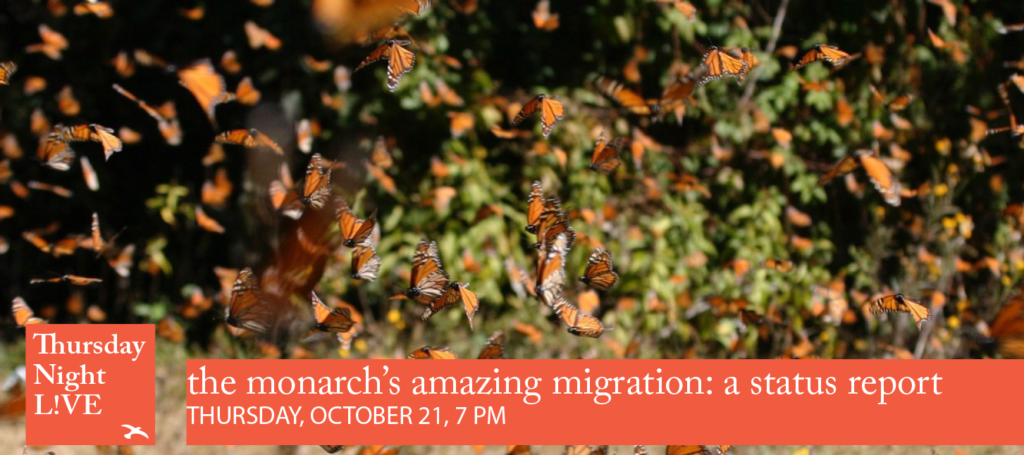
How are this year’s monarch’s doing? Join us and National Monarch expert Dr. Chip Taylor for our free, virtual event to find out.
The monarch butterfly, that large insect perfectly decked out for Halloween– or a Flyers game– in its orange and black cloak, undergoes one of the most extraordinary migrations in the animal kingdom. Butterflies across America and even Canada.
The monarch butterfly defies logic, for embedded in a small collection of nerve cells generously called a brain is a GPS directing the insect to fly from Roxborough all the way to a mountain valley near Mexico City, where it joins every other monarch from east of the Rockies (western monarchs head to the Pacific coast). As you read this, monarchs across the eastern US and even Canada are flying south, many along the eastern seaboard; most are near or even in Mexico already.
Once in Mexico, they gather in large groups to coat fir trees with millions of their bodies, a remarkable sight visited by thousands of eco-tourists annually. The butterflies wait out the long winter, living five months—Methuselah territory for an insect.
In early spring, they begin heading north, make it into Texas, lay their eggs—and die. It takes another generation or two for monarchs to make it back to Pennsylvania, not until early summer. So the butterflies hatching in my garden will start flying more than a thousand miles to a place they have never been. How’s that for Mother Nature’s planning?
If you’d like a treat, drive to Cape May point soon and watch clusters of them funneling down New Jersey hop across the Delaware Bay to get to the mainland and continue their journey south.
While it’s remarkable that an insect can make this migration, I’m saddened to report that this phenomenon is endangered as monarch numbers have plummeted in recent years, compromised by climate, pesticides, Midwestern “milkweed deserts,” and over-logging in Mexico.
So how are this year’s monarch’s doing? How is the insect holding up? Should it be declared an endangered species?
We hope to answer this question on Thursday, October 21 at 7:00 p.m. with our Thursday Night L!VE presentation, “The Monarch’s Amazing Migration: a Status Report.” National monarch expert Dr. Chip Taylor, founder and director of Monarch Watch, the organization that has helped place 35,000 monarch waystations across the country, joins us from his Kansas base to share the creature’s story and its status. Monarch Watch started in 1992 as an outreach program dedicated to engaging the public in studies of monarchs, and is now concentrating its efforts on monarch conservation.
“In real estate,” Dr. Taylor says, “it’s location, location, location. And for monarchs and other wildlife it’s habitat, habitat, habitat. We have a lot of habitat in this country, but we are losing it at a rapid pace. Development is consuming 6,000 acres a day, a loss of 2.2 million acres per year. Further, the overuse of herbicides along roadsides and elsewhere is turning diverse areas that support monarchs, pollinators, and other wildlife into grass-filled landscapes that support few species. The adoption of genetically modified soybeans and corn have further reduced monarch habitat. If these trends continue, monarchs are certain to decline, threatening the very existence of their magnificent migration.”
Female monarchs are exceptional botanists, laying their eggs only on one family of plants, the milkweeds. She tastes plants with her feet, laying eggs on the undersides of milkweed leaves. Caterpillars hatch from eggs, and immediately begin munching on milkweed—the only food they are adapted to eat. The creatures have evolved to take the noxious chemicals found in milkweed sap and use it to make themselves—both caterpillar and adult—bad-tasting for any bird that may try to eat it.
A very clever “Got Milkweed?” campaign was started years ago, and more and more home gardeners like me began planting milkweed– and the Schuylkill Center has been selling milkweeds for years.
To address these changes and restore habitats for monarchs, pollinators, and other wildlife, Monarch Watch is initiating a nationwide landscape restoration program called “Bring Back the Monarchs.” The goals of this program are to restore 20 milkweed species, used by monarch caterpillars as food, to their native ranges throughout the United States and to encourage the planting of nectar-producing native flowers that support adult monarchs and other pollinators.
This program is an outgrowth of the Monarch Waystation Program started by Monarch Watch in 2005. “While these sites, mostly habitats created in home gardens, schoolyards, parks, and commercial landscapes, contribute to monarch conservation, it is clear that to save the monarch migration we need to do more,” Taylor said. “ We need to think on a bigger scale and we need to think ahead, to anticipate how things are going to change as a result of population growth, development, changes in agriculture, and most of all, changes in the climate.”
According to Taylor, we need a comprehensive plan on how to manage the fragmented edges and marginal areas created by development and agriculture, since it is these edges that support monarchs, many of our pollinators, and the many forms of wildlife that are sustained by the seeds, fruits, nuts, berries, and foliage that result from pollination. “In effect,” Taylor argues, “we need a new conservation ethic, one dealing with edges and marginal areas that addresses the changes of the recent past and anticipates those of the future.”
Dr. Chip Taylor has been pioneering in butterfly conservation for decades. Meet him by joining me in a Thursday Night L!VE virtual lecture this week. Register for the free event.
By Mike Weilbacher, Executive Director
